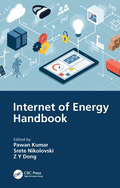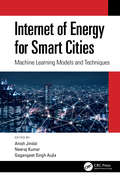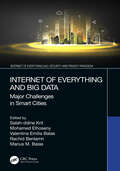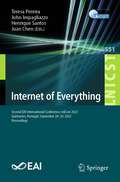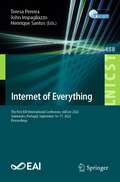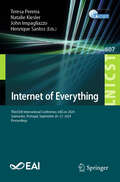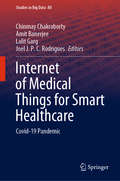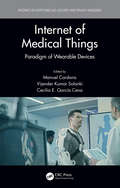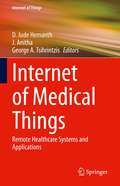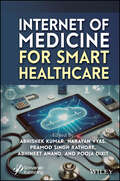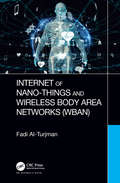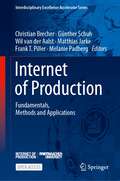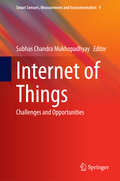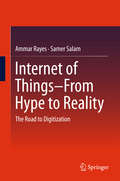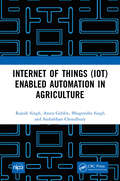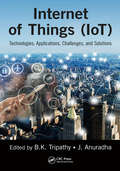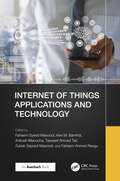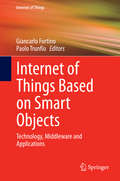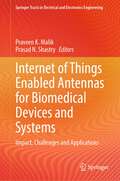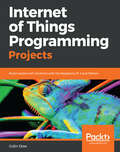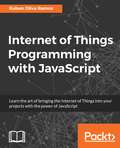- Table View
- List View
Internet of Energy Handbook
by Pawan Kumar Srete Nikolovski Z Y DongThe Internet of Energy (IoE), with the integration of advanced information and communication technologies (ICT), has led to a transformation of traditional networks to smart systems. Internet of Energy Handbook provides updated knowledge in the field of energy management with an Internet of Things (IoT) perspective. Features Explains the technological developments for energy management leading to a reduction in energy consumption through topics like smart energy systems, smart sensors, communication, techniques, and utilization Includes dedicated sections covering varied aspects related to renewable sources of energy, power distribution, and generation Incorporates energy efficiency, optimization, and sensor technologies Covers multidisciplinary aspects in computational intelligence and IoT Discusses building energy management aspects including temperature, humidity, the number of persons involved, and light intensity This handbook is aimed at graduate students, researchers, and professionals interested in power systems, IoT, smart grids, electrical engineering, and transmission.
Internet of Energy for Smart Cities: Machine Learning Models and Techniques
by Neeraj Kumar Gagangeet Singh Aujla Anish JindalMachine learning approaches has the capability to learn and adapt to the constantly evolving demands of large Internet-of-energy (IoE) network. The focus of this book is on using the machine learning approaches to present various solutions for IoE network in smart cities to solve various research gaps such as demand response management, resource management and effective utilization of the underlying ICT network. It provides in-depth knowledge to build the technical understanding for the reader to pursue various research problems in this field. Moreover, the example problems in smart cities and their solutions using machine learning are provided as relatable to the real-life scenarios. Aimed at Graduate Students, Researchers in Computer Science, Electrical Engineering, Telecommunication Engineering, Internet of Things, Machine Learning, Green computing, Smart Grid, this book: Covers all aspects of Internet of Energy (IoE) and smart cities including research problems and solutions. Points to the solutions provided by machine learning to optimize the grids within a smart city set-up. Discusses relevant IoE design principles and architecture. Helps to automate various services in smart cities for energy management. Includes case studies to show the effectiveness of the discussed schemes.
Internet of Everything and Big Data: Major Challenges in Smart Cities (Internet of Everything (IoE))
by Valentina Emilia Balas Rachid Benlamri Mohamed Elhoseny Salah-Ddine Krit Marius M. BalasThere currently is no in-depth book dedicated to the challenge of the Internet of Everything and Big Data technologies in smart cities. Humankind today is confronting a critical worldwide portability challenge and the framework that moves cities must keep pace with the innovation. Internet of Everything and Big Data: Major Challenges in Smart Cities reviews the applications, technologies, standards, and other issues related to smart cities.This book is dedicated to addressing the major challenges in realizing smart cities and sensing platforms in the era of Big Data cities and Internet of Everything. Challenges vary from cost and energy efficiency to availability and service quality. This book examines security issues and challenges, addresses the total information science challenges, covers exploring and creating IoT environment-related sales adaptive systems, and investigates basic and high-level concepts using the latest techniques implemented by researchers and businesses.The book is written for analysts, researchers, and specialists who are working on the future generation of the technologies. It will serve as a valuable guide for those in the industry, and students as well.
Internet of Everything: Second EAI International Conference, IoECon 2023, Guimarães, Portugal, September 28-29, 2023, Proceedings (Lecture Notes of the Institute for Computer Sciences, Social Informatics and Telecommunications Engineering #551)
by Juan Chen John Impagliazzo Henrique Santos Teresa PereiraThis book constitutes the refereed post-conference proceedings of the Second International Conference on Internet of Everything, IoECon 2023, which took place in Guimarães, Portugal, in September 2023. IoECon 2023 presents IoT paradigms to their whole dimension, intelligently connecting devices, people, processes, data, and things. IoE is multi-disciplinary and offers an opportunity to explore the co-relations between different areas, techniques, and theories about a new cyber world. The 11 revised full papers were carefully reviewed and selected from 38 submissions. The papers focus on a complete ecosystem that digitally interconnects everything, including people-to-people, people to-machines, and machines-to-machines.
Internet of Everything: The First EAI International Conference, IoECon 2022, Guimarães, Portugal, September 16-17, 2022, Proceedings (Lecture Notes of the Institute for Computer Sciences, Social Informatics and Telecommunications Engineering #458)
by John Impagliazzo Henrique Santos Teresa PereiraThis book constitutes the refereed post-conference proceedings of the EAI International Conference on Internet of Everything, IoECon 2022, which took place in Guimarães, Portugal in September 16-17 2022. IoECon 2022 presents IoE paradigms to their whole dimension, intelligently connecting devices, people, processes, data, and things. IoE is multi-disciplinary and offers an opportunity to explore the co-relations between different areas, techniques, and theories about a new cyber world.The 10 revised full papers were carefully reviewed and selected from 26 submissions. The papers focus on a complete ecosystem that digitally interconnects everything, including people-to-people, people-to-machines, and machines-to-machines.
Internet of Everything: Third EAI International Conference, IoECon 2024, Guimarães, Portugal, September 26–27, 2024, Proceedings (Lecture Notes of the Institute for Computer Sciences, Social Informatics and Telecommunications Engineering #607)
by John Impagliazzo Henrique Santos Teresa Pereira Natalie KieslerThis book constitutes the refereed post-conference proceedings of the Third International Conference on Internet of Everything, IoECon 2024, which took place in Guimarães, Portugal, in September 26–27, 2024. The 10 full papers were carefully reviewed and selected from 28 submissions.The papers cover the following topics: Machine-to-Machine (M2M); People-to-Machine (P2M) or Machine-to-People (M2P).
Internet of Medical Things for Smart Healthcare: Covid-19 Pandemic (Studies in Big Data #80)
by Amit Banerjee Joel J. P. C. Rodrigues Chinmay Chakraborty Lalit GargThis book covers COVID-19 related research works and focuses on recent advances in the Internet of Things (IoT) in smart healthcare technologies. It includes reviews and original works on COVID-19 in terms of e-healthcare, medicine technology, life support systems, fast detection, diagnoses, developed technologies and innovative solutions, bioinformatics, datasets, apps for diagnosis, solutions for monitoring and control of the spread of COVID-19, among other topics. The book covers comprehensive studies from bioelectronics and biomedical engineering, artificial intelligence, and big data with a prime focus on COVID-19 pandemic.
Internet of Medical Things: Paradigm of Wearable Devices (Internet of Everything (IoE))
by Vijender Kumar Solanki Manuel Cardona Cecilia E. GarcíaInternet of Things (IoT) has become a valuable tool for connection and information exchange between devices. This book provides a brief introduction to this new field, focuses on wearable medical devices, and covers the basic concepts by providing the reader with enough information to solve various practical problems. This book provides the latest applications, experiments, fundamentals concepts, and cutting-edge topics for the ehealth and wearable devices field. The book also offers topics related to Security in IoT and Wearable Devices, Wearable Devices and Internet of Medical Devices (IoMT), IoT for Medical Applications, and Tools and study cases. The book brings new and valuable information to PhD researchers, students, professors, and professionals working in IoT and related fields.
Internet of Medical Things: Remote Healthcare Systems and Applications (Internet of Things)
by George A. Tsihrintzis D. Jude Hemanth J. AnithaThis book looks at the growing segment of Internet of Things technology (IoT) known as Internet of Medical Things (IoMT), an automated system that aids in bridging the gap between isolated and rural communities and the critical healthcare services that are available in more populated and urban areas. Many technological aspects of IoMT are still being researched and developed, with the objective of minimizing the cost and improving the performance of the overall healthcare system. This book focuses on innovative IoMT methods and solutions being developed for use in the application of healthcare services, including post-surgery care, virtual home assistance, smart real-time patient monitoring, implantable sensors and cameras, and diagnosis and treatment planning. It also examines critical issues around the technology, such as security vulnerabilities, IoMT machine learning approaches, and medical data compression for lossless data transmission and archiving. Internet of Medical Things is a valuable reference for researchers, students, and postgraduates working in biomedical, electronics, and communications engineering, as well as practicing healthcare professionals.
Internet of Medicine for Smart Healthcare
by Abhishek Kumar Pramod Singh Rathore Abhineet Anand Narayan Vyas Pooja DixitThis book provides in-depth explanations and discussions of the latest applications of Artificial Intelligence (AI), machine learning, and the Internet of Medicine, offering readers the cutting edge on this rapidly growing technology that has the potential to transform healthcare and improve patient outcomes. Over the past five years, there have been significant advances in healthcare through the use of artificial intelligence (AI) and machine learning (ML) technologies. AI and machine learning in medical imaging has significantly improved the accuracy and speed of medical imaging analysis, accelerated the drug discovery process by identifying potential drug targets and predicting the efficacy and safety of new drugs, and enabled personalized medicine by analyzing large amounts of patient data to identify individualized treatment plans based on a patient’s genetic makeup and medical history. Internet of Medicine (IoM) refers to the integration of the Internet of Things (IoT) and connected medical devices with healthcare systems and processes to enable remote monitoring, diagnosis, and treatment of patients. IoM is a subset of the larger Internet of Things concept, which involves the connection of everyday devices and appliances to the internet for various purposes. IoM has the potential to revolutionize healthcare by improving patient outcomes, reducing costs, and increasing efficiency. Some of the specific applications of IoM include remote patient monitoring, real-time data analysis, predictive analytics, smart hospitals, and personalized medicine.
Internet of Nano-Things and Wireless Body Area Networks (WBAN)
by Fadi Al-TurjmanThe Internet of Nano-Things (IoNT) is a system of nano-connected devices, objects, or organisms that have unique identifiers to transfer data over a computer or cellular network wirelessly to the Cloud. Data delivery, caching, and energy consumption are among the most significant topics in the IoNT nowadays. The book addresses data routing and energy consumption challenges and proposes nano-sensing platforms in critical Wireless Body Area Networks (WBAN). This book covers both design and implementation aspects of data delivery models and strategies in a smart application enabled by the WBAN. It focuses on smart data delivery approaches and energy savings aspects in a reliable IoNT systems.
Internet of Production: Fundamentals, Methods and Applications (Interdisciplinary Excellence Accelerator Series)
by Matthias Jarke Christian Brecher Günther Schuh Frank T. Piller Wil van der Aalst Melanie PadbergThis seminal compendium, available through open access, illuminates the forefront of digital collaboration in production. It introduces the visionary concept of the Internet of Production (IoP), an ambitious initiative by Germany's esteemed Cluster of Excellence at RWTH Aachen University. This handbook pioneers the integration of data, models, and knowledge across development, production, and user cycles, offering interdisciplinary insights into production technology's horizons with the overall objective to create a worldwide lab.The work is organized into seven key parts, each contributing to a comprehensive understanding of the IoP. Part I lays the foundation with interdisciplinary visions and concepts. Part II delves into IoP's infrastructure, encompassing digital shadows and actionable artificial intelligence. Part III examines materials within the digitalized production landscape. Part IV confronts the challenges and potentials of production processes under novel digitalization methods.Part V focuses on production management with data-driven decision support, while Part VI explores agile development processes. Finally, Part VII delves into the interplay between internal and external perspectives in the IoP, human-centered work design, and platform-based ecosystems.Supported by the German Research Foundation (DFG), this compendium redefines manufacturing through the transformative IoP lens. Embrace this scholarly endeavor to embrace technological advancement. This is an open access book.
Internet of Things
by Subhas Chandra MukhopadhyayAdvancement in sensor technology, smart instrumentation, wireless sensor networks, miniaturization, RFID and information processing is helping towards the realization of Internet of Things (IoT). IoTs are finding applications in various area applications including environmental monitoring, intelligent buildings, smart grids and so on. This book provides design challenges of IoT, theory, various protocols, implementation issues and a few case study. The book will be very useful for postgraduate students and researchers to know from basics to implementation of IoT.
Internet of Things From Hype to Reality
by Ammar Rayes Salam SamerThis book comprehensively describes an end-to-end Internet of Things (IoT) architecture that is comprised of devices, network, compute, storage, platform, applications along with management and security components. It is organized into five main parts, comprising of a total of 11 chapters. Part I presents a generic IoT reference model to establish a common vocabulary for IoT solutions. This includes a detailed description of the Internet protocol layers and the Things (sensors and actuators) as well as the key business drivers to realize the IoT vision. Part II focuses on the IoT requirements that impact networking protocols and provides a layer-by-layer walkthrough of the protocol stack with emphasis on industry progress and key gaps. Part III introduces the concept of Fog computing and describes the drivers for the technology, its constituent elements, and how it relates and differs from Cloud computing. Part IV discusses the IoT services platform, the cornerstone of the solution followed by the Security functions and requirements. Finally, Part V provides a treatment of the topic of connected ecosystems in IoT along with practical applications. It then surveys the latest IoT standards and discusses the pivotal role of open source in IoT. "Faculty will find well-crafted questions and answers at the end of each chapter, suitable for review and in classroom discussion topics. In addition, the material in the book can be used by engineers and technical leaders looking to gain a deep technical understanding of IoT, as well as by managers and business leaders looking to gain a competitive edge and understand innovation opportunities for the future. " Dr. Jim Spohrer, IBM "This text provides a very compelling study of the IoT space and achieves a very good balance between engineering/technology focus and business context. As such, it is highly-recommended for anyone interested in this rapidly-expanding field and will have broad appeal to a wide cross-section of readers, i. e. , including engineering professionals, business analysts, university students, and professors. " Professor Nasir Ghani, University of South Florida
Internet of Things (IoT) Enabled Automation in Agriculture
by Rajesh Singh Sushabhan Choudhury Anita Gehlot Bhupendra SinghThis book provides basic knowledge of the programming and interfacing of devices with IoT modem and programming. The aim is to explain the basic steps to understand the IoT and its application in agriculture field. It will serve be a reference book for postgraduate and undergraduate Engineering students. Students from Electronics, Electrical, Mechatronics, Robotics, Mechanical, Computer science can use the book for their projects and research. This book is based entirely on the practical experience of the authors while undergoing projects with the students and industries. This book is co-published with NIPA. Taylor and Francis does not sell or distribute its print and electronic editions in India, Pakistan, Nepal, Bhutan, Bangladesh and Sri Lanka.
Internet of Things (IoT): Technologies, Applications, Challenges and Solutions
by B. K. Tripathy J. AnuradhaThe term IoT, which was first proposed by Kevin Ashton, a British technologist, in 1999 has the potential to impact everything from new product opportunities to shop floor optimization to factory worker efficiency gains, that will power top-line and bottom-line gains. As IoT technology is being put to diversified use, the current technology needs to be improved to enhance privacy and built secure devices by adopting a security-focused approach, reducing the amount of data collected, increasing transparency and providing consumers with a choice to opt out. Therefore, the current volume has been compiled, in an effort to draw the various issues in IoT, challenges faced and existing solutions so far. Key Points: • Provides an overview of basic concepts and technologies of IoT with communication technologies ranging from 4G to 5G and its architecture. • Discusses recent security and privacy studies and social behavior of human beings over IoT. • Covers the issues related to sensors, business model, principles, paradigms, green IoT and solutions to handle relevant challenges. • Presents the readers with practical ideas of using IoT, how it deals with human dynamics, the ecosystem, the social objects and their relation. • Deals with the challenges involved in surpassing diversified architecture, protocol, communications, integrity and security.
Internet of Things - ICIOT 2020: 5th International Conference, Held as Part of the Services Conference Federation, SCF 2020, Honolulu, HI, USA, September 18–20, 2020, Proceedings (Lecture Notes in Computer Science #12405)
by Wei Song Liang-Jie Zhang Kisung Lee Zhisheng Yan Huan ChenThis book constitutes the proceedings of the International Conference on Internet of Things, ICIOT 2020, held virtually as part of SCF 2020, in Honolulu, HI, USA, in September 2020. The 8 full and 4 short papers presented in this volume were carefully reviewed and selected from 20 submissions. The conference Internet of Things (ICIOT 2020) covers state-of-the-art technologies and best practices of Internet of Things, as well as emerging standards and research topics which would define the future of Internet of Things.
Internet of Things Applications and Technology
by Faheem Syeed Masoodi Zubair Sayeed Masoodi Alwi M. Bamhdi Ankush Manocha Tawseef Ahmed Teli Faheem Ahmad ReeguThe book provides a comprehensive examination of the integration of IoT technology into various industries and its impact on daily life, with a focus on the most recent advancements in the field. The technical aspects of IoT are thoroughly discussed, including the implementation of cutting-edge sensors, data communication protocols, and network topologies. The book also covers the latest advancements in areas such as edge computing, 5G networks, and AI-powered IoT devices. Emphasis is placed on the examination of IoT in real-world applications, including healthcare, agriculture, transportation, and home automation. Other highlights of the book include: IoT-based systems for monitoring air and water quality Wearable devices for continuous monitoring of vital signs and other health metrics IoT-based systems for monitoring and optimizing crop growth and yields Connected vehicles for improved safety, efficiency, and traffic management Monitoring of goods and resources in transit to optimize delivery times With case studies and real-world examples, readers gain a comprehensive understanding of how IoT is revolutionizing various industries and enhancing daily life. This book is a comprehensive guide to the exciting world of IoT and its practical application.
Internet of Things Based Smart Healthcare: Intelligent and Secure Solutions Applying Machine Learning Techniques (Smart Computing and Intelligence)
by Chuan-Ming Liu Biswaranjan Acharya Chandreyee Chowdhury Suparna BiswasThis book provides both the developers and the users with an awareness of the challenges and opportunities of advancements in healthcare paradigm with the application and availability of advanced hardware, software, tools, technique or algorithm development stemming the Internet of Things. The book helps readers to bridge the gap in their three understanding of three major domains and their interconnections: Hardware tested and software APP development for data collection, intelligent protocols for analysis and knowledge extraction. Medical expertise to interpret extracted knowledge towards disease prediction or diagnosis and support. Security experts to ensure data correctness for precise advice. The book provides state-of-the-art overviews by active researchers, technically elaborating healthcare architectures/frameworks, protocols, algorithms, methodologies followed by experimental results and evaluation. Future direction and scope will be precisely documented for interested readers.
Internet of Things Based on Smart Objects
by Giancarlo Fortino Paolo TrunfioThe Internet of Things (IoT) usually refers to a world-wide network of interconnected heterogeneous objects (sensors, actuators, smart devices, smart objects, RFID, embedded computers, etc) uniquely addressable, based on standard communication protocols. Beyond such a definition, it is emerging a new definition of IoT seen as a loosely coupled, decentralized system of cooperating smart objects (SOs). A SO is an autonomous, physical digital object augmented with sensing/actuating, processing, storing, and networking capabilities. SOs are able to sense/actuate, store, and interpret information created within themselves and around the neighbouring external world where they are situated, act on their own, cooperate with each other, and exchange information with other kinds of electronic devices and human users. However, such SO-oriented IoT raises many in-the-small and in-the-large issues involving SO programming, IoT system architecture/middleware and methods/methodologies for the development of SO-based applications. This Book will specifically focus on exploring recent advances in architectures, algorithms, and applications for an Internet of Things based on Smart Objects. Topics appropriate for this Book include, but are not necessarily limited to: - Methods for SO development - IoT Networking - Middleware for SOs - Data Management for SOs - Service-oriented SOs - Agent-oriented SOs - Applications of SOs in Smart Environments: Smart Cities, Smart Health, Smart Buildings, etc. Advanced IoT Projects.
Internet of Things Enabled Antennas for Biomedical Devices and Systems: Impact, Challenges and Applications (Springer Tracts in Electrical and Electronics Engineering)
by Prasad N. Shastry Praveen K. MalikThe book consists of the latest research in biomedical and communication integration. It discusses the fabrication and testing outcomes of the Internet of Things-enabled biomedical applications. The book focuses on recent advances in the field of planar antenna design and their applications in space communication, mobile communication, wireless communication, and wearable applications. Planar antennas are also used in medical applications in microwave imaging, medical implants, hyperthermia treatments, and wireless wellness monitoring. This book presents planar antenna design concepts, methods, and techniques to enhance the performance parameters and applications for IoT and device-to-device communication. It provides the latest techniques used for the design of antennas in terms of their structures, defected ground, MIMO, and fractal design. This book also addresses the specific steps to resolve issues in designing antennas and how to design conformal and miniaturized antenna structures for various applications.
Internet of Things From Hype to Reality: The Road to Digitization
by Ammar Rayes Samer SalamThis textbook presents an end-to-end Internet of Things (IoT) architecture that comprises of devices, network, compute, storage, platform, applications along with management and security components with focus on the missing functionality in the current state of the art. As with the first edition, it is organized into six main parts: an IoT reference model; Fog computing and the drivers; IoT management and applications ranging from smart homes to manufacturing and energy conservation solutions; Smart Services in IoT; IoT standards; and case studies. The textbook edition features a new chapter entitled The Blockchain in IoT, updates based on latest standards and technologies, and new slide ware for professors. It features a full suite of classroom material for easy adoption.
Internet of Things Integrated Augmented Reality (SpringerBriefs in Applied Sciences and Technology)
by Nilanjan Dey Gitanjali Rahul Shinde Prashant Shantaram Dhotre Parikshit Narendra MahalleThis book discusses the use of converged technology, a rapidly growing area that enhancements smart devices, communication, Internet of things (IoT), and augmented reality (AR). The book also explores the need for convergence of IoT and AR for various purposes, like personalized services, context awareness, and bridging the gap between the physical and digital world. Furthermore, it examines the implementation of IoT and AR in use cases to define pathways that allow application developers to design modern solutions to satisfy requirements like scalability, abstraction and security. Featuring an introduction, and covering sensing techniques, and effective architecture in AR-based IoT real-time use cases, the book also addresses the issues and challenges in designing standard architecture and middleware to support diverse applications. Given its scope, it is a valuable resource for teachers and students in engineering, as well as researchers, developers, and users working in multi-disciplinary areas.
Internet of Things Programming Projects: Build modern IoT solutions with the Raspberry Pi 3 and Python
by Colin DowA practical project-based guide to help you build and control your IoT projects Key Features Leverage the full potential of IoT with the combination of Raspberry Pi 3 and Python Build complex Python-based applications with IoT Work on various IoT projects and understand the basics of electronics Book Description The Internet of Things (IOT) has managed to attract the attention of researchers and tech enthusiasts, since it powerfully combines classical networks with instruments and devices. In Internet of Things Programming Projects, we unleash the power of Raspberry Pi and Python to create engaging projects. In the first part of the book, you'll be introduced to the Raspberry Pi, learn how to set it up, and then jump right into Python programming. Then, you'll dive into real-world computing by creating a“Hello World” app using flash LEDs. As you make your way through the chapters, you'll go back to an age when analog needle meters ruled the world of data display. You'll learn to retrieve weather data from a web service and display it on an analog needle meter, and build a home security system using the Raspberry Pi. The next project has a modern twist, where we employ the Raspberry Pi to send a signal to a web service that will send you a text when someone is at the door. In the final project, you take what you've learned from the previous two projects and create an IoT robot car that you can use to monitor what your pets are up to when you are away. By the end of this book, you will be well versed in almost every possible way to make your IoT projects stand out. What you will learn Install and set up a Raspberry Pi for IoT development Learn how to use a servo motor as an analog needle meter to read data Build a home security dashboard using an infrared motion detector Communicate with a web service that sends you a message when the doorbell rings Receive data and display it with an actuator connected to the Raspberry Pi Build an IoT robot car that is controlled through the internet Who this book is for Internet of Things Programming Projects is for Python developers and programmers who are interested in building their own IoT applications and IoT-based projects. It is also targeted at IoT programmers and developers who are looking to build exciting projects with Python.
Internet of Things Programming with JavaScript
by Ruben Oliva RamosLearn the art of bringing the Internet of Things into your projects with the power of JavaScript About This Book • This is a practical guide to help you configure and build a complete distributed IoT system from scratch using JavaScript • Utilize the power of Node and HTML5 to develop web services and a centralized web server, enabling high-level communication between connected devices • Control all your connected devices from the browser by setting up a common dashboard Who This Book Is For This book is for developers who are interested in learning how to communicate with connected devices in JavaScript to set up an IoT system. Some basic knowledge of JavaScript is expected. Hobbyists who want to explore the potential of IoT in JavaScript will also find this book useful. What You Will Learn • Develop the skills to connected devices prepared the field to interact with the devices in a network system Internet of Things • Find out how to connect sensors and actuators to the devices • Send data to a web server connected devices • Understand Internet of things using web services and database • Configure a dashboard using HTML5 and JavaScript • Control devices connected from a dashboard • Monitor different devices from the dashboard • Build an app for a smartphone to control different devices In Detail The Internet of Things (IoT) is an entirely new platform for developers and engineers, but one thing that remains consistent as we move into this new world, are the programming languages. JavaScript is the most widely used language over the Internet, and with IoT gaining momentum, you will learn how to harness the power of JavaScript to interact with connected devices. This book will teach you how to interact with endpoint devices by developing web services in JavaScript and also set up an interface to control all connected devices. This book begins with setting up a centralized web server that serves as a hub for all connected devices. The book then progresses further towards building web services to facilitate high-level communication between connected devices. Using Arduino and Raspberry Pi Zero as endpoint devices, the book will show you how devices can communicate with each other, perform a wide range of tasks, and also be controlled from a centralized location using JavaScript. The book ends with creating a hybrid app to control the devices that can be run from a browser or installed on a smartphone. Style and approach This book offers step-by-step guidance on how to set up a distributed IoT system using JavaScript. It will teach you how to interact with endpoint devices by developing web services in JavaScript and also set up an interface for controlling all connected devices.
